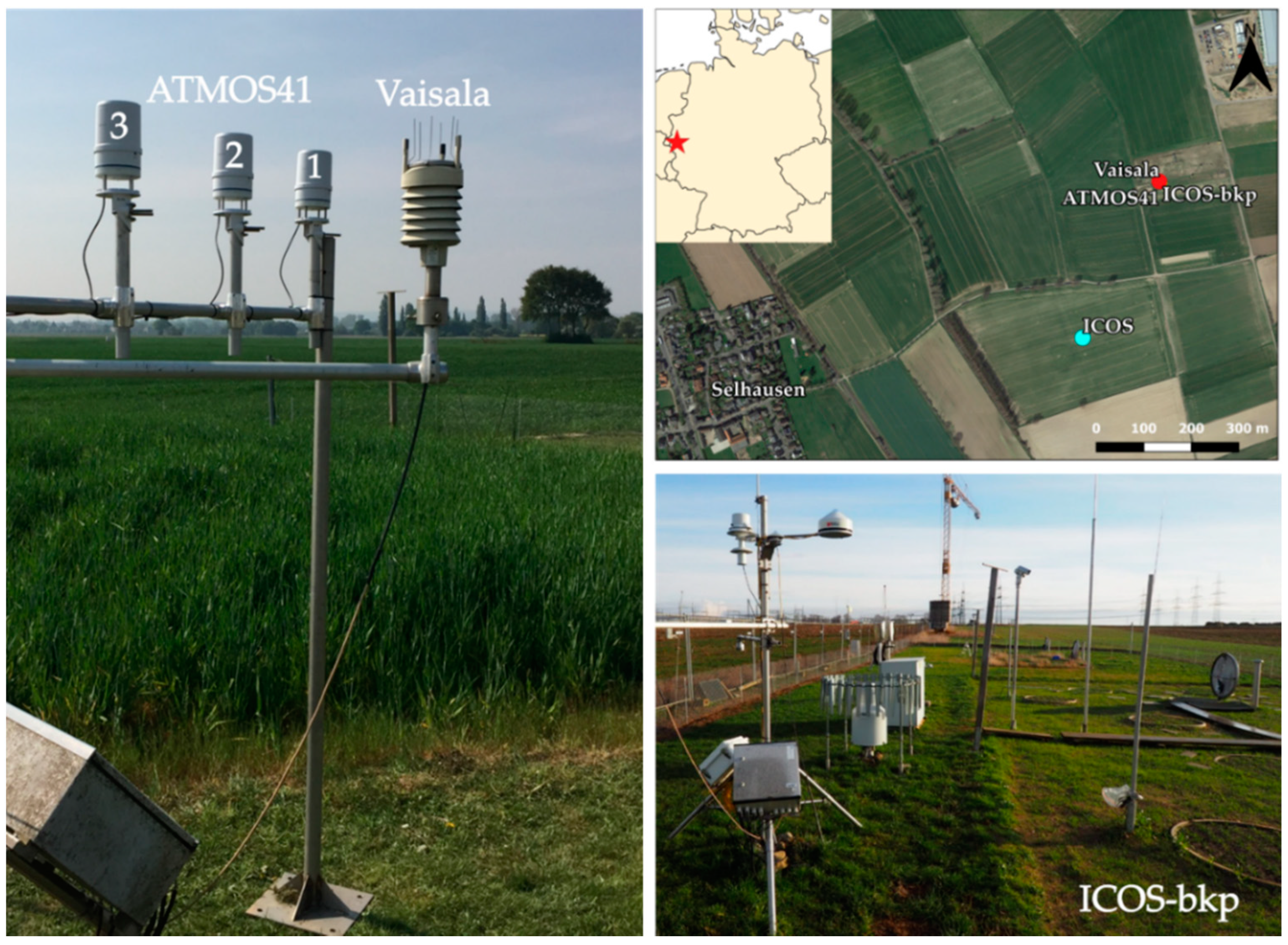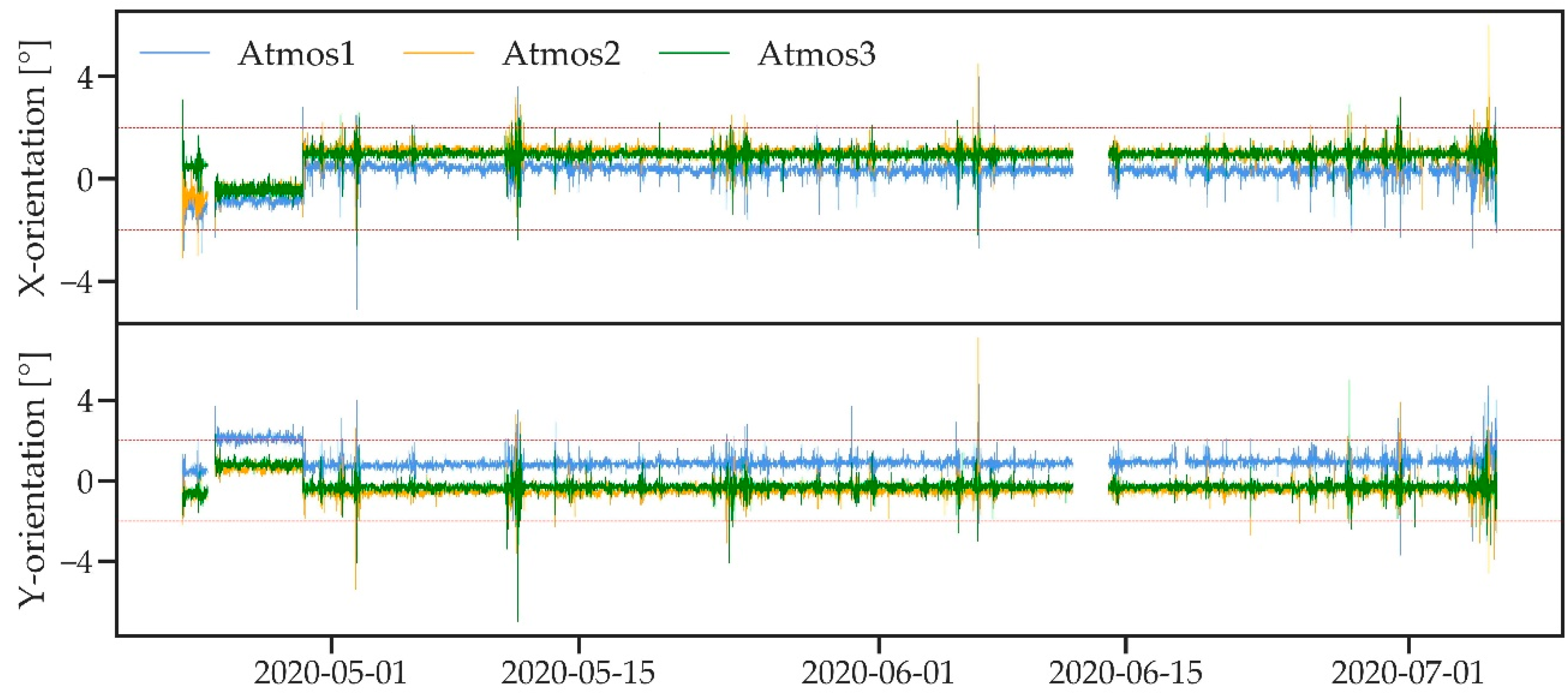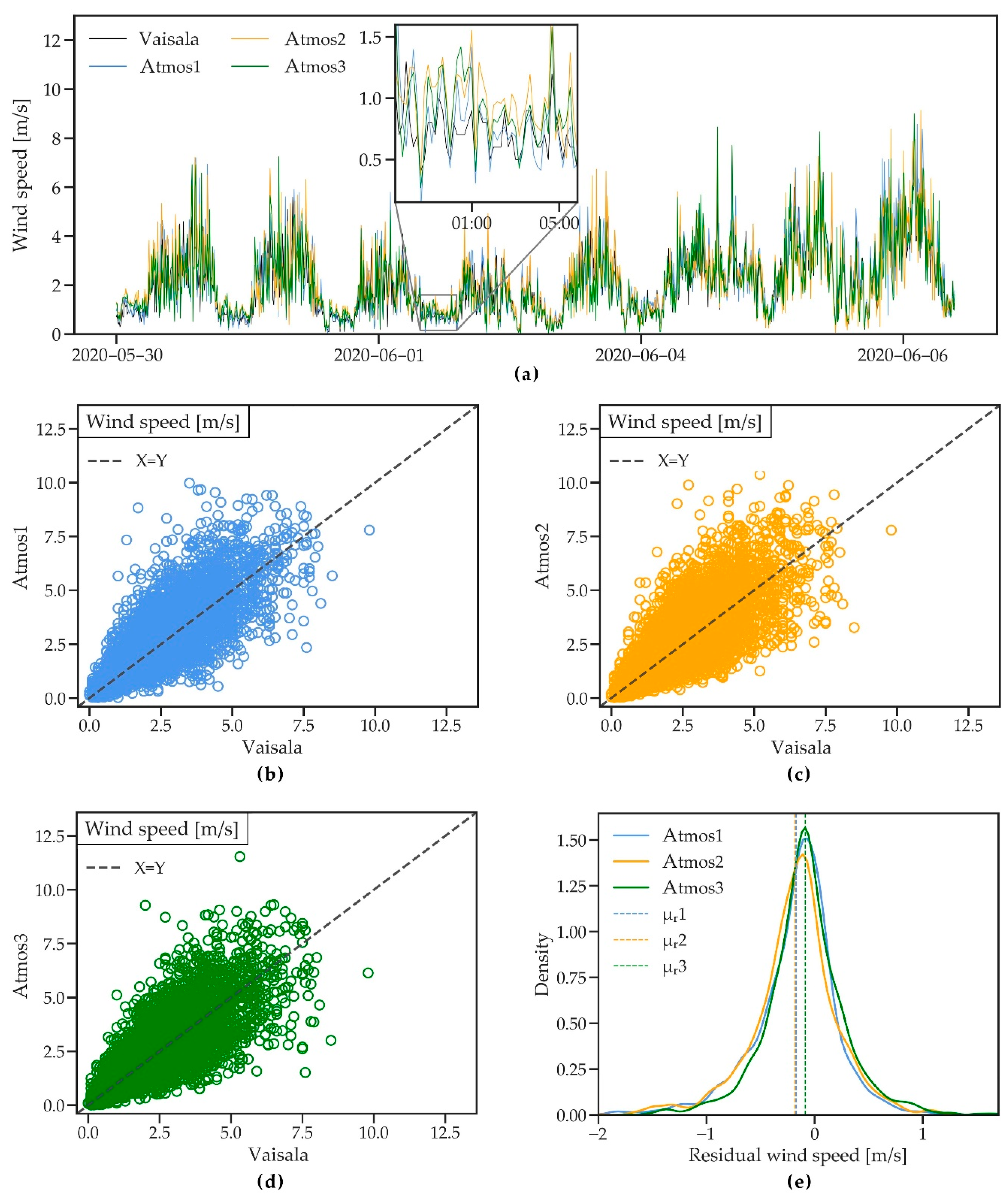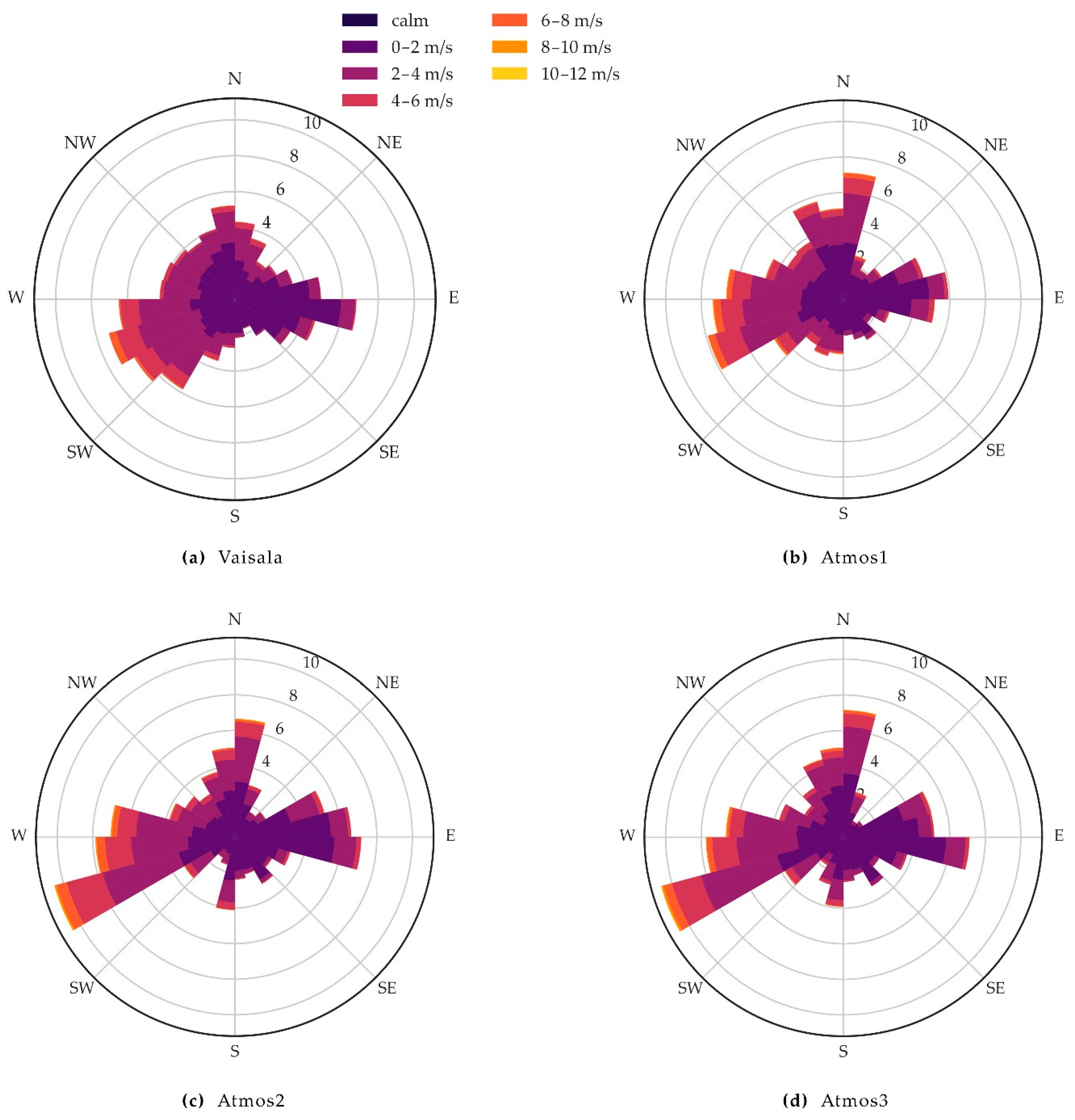Performance of the ATMOS41 All-in-One Weather Station for Weather Monitoring
Abstract
:1. Introduction
- What is the quality of weather data from the ATMOS41 weather station?
- What systematic or random errors affect the ATMOS41 station?
- How well does the ATMOS41 station perform compared to a high precision, high quality weather station?
- What are the limitations of the ATMOS41 station?
2. Materials and Methods
2.1. ATMOS41 All-in-One Weather Station
2.2. Reference Weather Station
2.3. Experimental Setup
2.4. Performance Analysis
3. Results and Discussion
3.1. ATMOS41 Inter-Sensor Variability
3.2. Comparison of ATMOS41 with ICOS Backup Station
3.2.1. Solar Radiation
3.2.2. Precipitation
3.2.3. Air Temperature
3.2.4. Atmospheric Pressure
3.2.5. Relative Humidity
3.2.6. Wind Speed and Direction
4. Conclusions
Author Contributions
Funding
Institutional Review Board Statement
Informed Consent Statement
Data Availability Statement
Acknowledgments
Conflicts of Interest
Appendix A



References
- World Meteorological Organization: The Global Observing System for Climate: Implementation Needs. Available online: https://library.wmo.int/doc_num.php?explnum_id=3417 (accessed on 10 November 2020).
- Nsabagwa, M.; Byamukama, M.; Kondela, E.; Otim, J.S. Towards a robust and affordable Automatic Weather Station. Dev. Eng. 2019, 4, 100040. [Google Scholar] [CrossRef]
- Pietrosemoli, E.; Rainone, M.; Zennaro, M. On Extending the Wireless Communications Range of Weather Stations using LoRaWAN. In GoodTechs’19: EAI International Conference on Smart Objects and Technologies for Social Good, Valencia, Spain, 25–27 September 2019; ACM: New York, NY, USA, 2019; pp. 78–83. [Google Scholar]
- Sabatini, F. Setting up and Managing Automatic Weather Stations for Remote Sites Monitoring: From Niger to Nepal. In Renewing Local Planning to Face Climate Change in the Tropics; Tiepolo, M., Pezzoli, A., Tarchiani, V., Eds.; Green Energy and Technology; Springer International Publishing: Cham, Switzerland, 2017; pp. 21–39. [Google Scholar]
- WMO: Progress/Activity Reports Presented at CBS-XIV (Unedited). Available online: https://library.wmo.int/doc_num.php?explnum_id=5515 (accessed on 15 November 2020).
- de la Concepcion, A.R.; Stefanelli, R.; Trinchero, D. Ad-hoc multilevel wireless sensor networks for distributed microclimatic diffused monitoring in precision agriculture. In Proceedings of the 2015 IEEE Topical Conference on Wireless Sensors and Sensor Networks (WiSNet), San Diego, CA, USA, 25–28 January 2015; pp. 14–16. [Google Scholar]
- Tenzin, S.; Siyang, S.; Pobkrut, T.; Kerdcharoen, T. Low cost weather station for climate-smart agriculture. In Proceedings of the 2017 9th International Conference on Knowledge and Smart Technology (KST), Chonburi, Thailand, 1–4 February 2017; pp. 172–177. [Google Scholar]
- Watthanawisuth, N.; Tuantranont, A.; Kerdcharoen, T. Microclimate real-time monitoring based on ZigBee sensor network. In Proceedings of the 2009 IEEE Sensors, Christchurch, New Zealand, 25–28 October 2009; pp. 1814–1818. [Google Scholar]
- Gaitani, N.; Spanou, A.; Saliari, M.; Synnefa, A.; Vassilakopoulou, K.; Papadopoulou, K.; Pavlou, K.; Santamouris, M.; Papaioannou, M.; Lagoudaki, A. Improving the microclimate in urban areas: A case study in the centre of Athens. Build. Serv. Eng. Res. Technol. 2011, 32, 53–71. [Google Scholar] [CrossRef]
- Tomlinson, C.J.; Prieto-Lopez, T.; Bassett, R.; Chapman, L.; Cai, X.; Thornes, J.E.; Baker, C. Showcasing urban heat island work in Birmingham-measuring, monitoring, modelling and more. Weather 2013, 68, 44–49. [Google Scholar] [CrossRef]
- Yick, J.; Mukherjee, B.; Ghosal, D. Wireless sensor network survey. Comput. Netw. 2008, 52, 2292–2330. [Google Scholar] [CrossRef]
- Lopez, J.C.B.; Villaruz, H.M. Low-cost weather monitoring system with online logging and data visualization. In Proceedings of the 2015 International Conference on Humanoid, Nanotechnology, Information Technology, Communication and Control, Environment and Management (HNICEM), Cebu City, Philippines, 9–12 December 2015; pp. 1–6. [Google Scholar]
- Katyal, A.; Yadav, R.; Pandey, M. Wireless arduino based weather station. Int. J. Adv. Res. Comput. Commun. Eng. 2016, 5, 274–276. [Google Scholar]
- Saini, H.; Thakur, A.; Ahuja, S.; Sabharwal, N.; Kumar, N. Arduino based automatic wireless weather station with remote graphical application and alerts. In Proceedings of the 2016 3rd International Conference on Signal Processing and Integrated Networks (SPIN), Noida, India, 11–12 February 2016; pp. 605–609. [Google Scholar]
- Savić, T.; Radonjić, M. One approach to weather station design based on Raspberry Pi platform. In Proceedings of the 2015 23rd Telecommunications Forum Telfor (TELFOR), Belgrade, Serbia, 24–26 November 2015; pp. 623–626. [Google Scholar]
- Kapoor, P.; Barbhuiya, F.A. Cloud Based Weather Station using IoT Devices. In Proceedings of the TENCON 2019-2019 IEEE Region 10 Conference (TENCON), Kochi, India, 17–20 October 2019; pp. 2357–2362. [Google Scholar]
- Gunawardena, N.; Pardyjak, E.R.; Stoll, R.; Khadka, A. Development and evaluation of an open-source, low-cost distributed sensor network for environmental monitoring applications. Meas. Sci. Technol. 2018, 29, 024008. [Google Scholar] [CrossRef]
- Aponte-Roa, D.A.; Montalvan, L.B.; Velazquez, C.; Espinoza, A.A.; Velazquez, L.F.; Serrano, R. Evaluation of a low-cost, solar-powered weather station for small-scale wind farm site selection. In Proceedings of the 2018 IEEE International Instrumentation and Measurement Technology Conference (I2MTC), Houston, TX, USA, 14–17 May 2018; pp. 1–5. [Google Scholar]
- Muller, C.; Chapman, L.; Johnston, S.; Kidd, C.; Illingworth, S.; Foody, G.; Overeem, A.; Leigh, R. Crowdsourcing for climate and atmospheric sciences: Current status and future potential. Int. J. Climatol. 2015, 35, 3185–3203. [Google Scholar] [CrossRef] [Green Version]
- Climatronics Corporation: All-In-One (AIO) Weather Sensor. Available online: http://www.climatronics.com/Products/Weather-Station-Systems/AIO_compact_weather_station.php (accessed on 2 November 2020).
- Gill MaxiMet GMX600 Compact Weather Station. Available online: http://www.gillinstruments.com/data/datasheets/1957-010%20Maximet-gmx600%20Iss%208.pdf (accessed on 2 November 2020).
- Environmental Expert: WeatherHawk-Model 620-Wireless Weather Station. Available online: https://www.environmental-expert.com/products/weatherhawk-model-620-wireless-weather-station-302957 (accessed on 2 November 2020).
- Warne, J. Editor Guidelines on Economical Alternative AWS. In Commission for Instruments and Methods of Observation: Joint Session of the Expert Team on Operational In Situ Technologies (ET-OIST) and the Expert Team on Developments in In Situ Technologies (ET-DIST); WMO: Geneva, Switzerland, 2017. [Google Scholar]
- Mutuku, E.A.; Roobroeck, D.; Vanlauwe, B.; Boeckx, P.; Cornelis, W.M. Maize production under combined Conservation Agriculture and Integrated Soil Fertility Management in the sub-humid and semi-arid regions of Kenya. Field Crops Res. 2020, 254, 107833. [Google Scholar] [CrossRef]
- TAHMO. Available online: https://tahmo.org/ (accessed on 1 November 2020).
- van de Giesen, N.; Hut, R.; Selker, J. The Trans-African Hydro-Meteorological Observatory (TAHMO): The Trans-African Hydro-Meteorological Observatory. Wiley Interdiscip. Rev. Water 2014, 1, 341–348. [Google Scholar] [CrossRef] [Green Version]
- Brito, T.; Pereira, A.I.; Lima, J.; Valente, A. Wireless Sensor Network for Ignitions Detection: An IoT approach. Electronics 2020, 9, 893. [Google Scholar] [CrossRef]
- Valente, A.; Silva, S.; Duarte, D.; Cabral Pinto, F.; Soares, S. Low-Cost LoRaWAN Node for Agro-Intelligence IoT. Electronics 2020, 9, 987. [Google Scholar] [CrossRef]
- Jencso, K.; Hyde, K.; Bocinsky, K.; Hoylman, Z.H. The Montana Mesonet-a Nascent Wireless Network in the Upper Missouri River Basin. In Proceedings of the AGU Fall Meeting Abstracts, San Francisco, CA, USA, 1 December 2019; p. PA11C-0955. [Google Scholar]
- Mohamed, A.Z.; Osroosh, Y.; Peters, T.R.; Bates, T.; Campbell, C.S.; Ferrer-Alegre, F. Morning crop water stress index as a sensitive indicator of water status in apple trees. In Proceedings of the 2019 ASABE Annual International Meeting, Boston, MA, USA, 7–10 July 2019; pp. 1900577:1–1900577:8. [Google Scholar]
- Xie, W.; Kimura, M.; Iida, T.; Kubo, N. Simulation of water temperature in paddy fields by a heat balance model using plant growth status parameter with interpolated weather data from weather stations. Paddy Water Environ. 2021, 19, 35–54. [Google Scholar] [CrossRef]
- METER: Scientific Weather Station Performance Data and Weather Sensor Comparisons. Available online: https://www.metergroup.com/environment/articles/weather-sensor-comparison-scientific-weather-station-performance-data-2/ (accessed on 4 December 2020).
- Anand, M.; Molnar, P. Performance of TAHMO Zurich Weather Station; Institute of Environmental Engineering, D-Baug: ETH Zurich, Switzerland, 2018. [Google Scholar]
- Khalil, A. Email correspondance with Ayman Khalil from METER Europe Support (support.europe@metergroup.com). Available online: https://www.metergroup.com/contact/ (accessed on 13 October 2020).
- Schmidt, M.; Reichenau, T.G.; Fiener, P.; Schneider, K. The carbon budget of a winter wheat field: An eddy covariance analysis of seasonal and inter-annual variability. Agric. For. Meteorol. 2012, 165, 114–126. [Google Scholar] [CrossRef]
- ICOS: Selhausen (C1). Available online: http://www.icos-infrastruktur.de/en/icos-d/komponenten/oekosysteme/beobachtungsstandorte/selhausen-c1/ (accessed on 6 November 2020).
- World Meteorological Organization. Guide to Instruments and Methods of Observation (WMO No. 8), 7th ed.; WMO: Geneva, Switzerland, 2008. [Google Scholar]
- Laurent, O. ICOS Atmospheric Station Specifications; ICOS: Helsinki, Finland, 2017. [Google Scholar]
- Brus, M.; Vesala, T.; Juurola, E.; Kaukolehto, M. Stakeholders Handbook; ICOS: Helsinki, Finland, 2013. [Google Scholar]
- TERENO-Terrestrial Environmental Observatories. Available online: https://www.tereno.net (accessed on 1 November 2020).
- METER Group, I.U. ATMOS41 User Manual; METER Group: Pullman, WA, USA, 2017. [Google Scholar]
- Walther, B.A.; Moore, J.L. The concepts of bias, precision and accuracy, and their use in testing the performance of species richness estimators, with a literature review of estimator performance. Ecography 2005, 28, 815–829. [Google Scholar] [CrossRef]
- Ruiz, G.; Bandera, C. Validation of Calibrated Energy Models: Common Errors. Energies 2017, 10, 1587. [Google Scholar] [CrossRef] [Green Version]
- Niederschlag: Vieljährige Mittelwerte 1981–2010; Station Juelich (Forsch.-Anlage). Available online: https://www.dwd.de/DE/leistungen/klimadatendeutschland/mittelwerte/nieder_8110_fest_html.html?view=nasPublication&nn=16102 (accessed on 11 January 2021).
- Sieck, L.C.; Burges, S.J.; Steiner, M. Challenges in obtaining reliable measurements of point rainfall. Water Resour. Res. 2007, 43, W01420:1–W01420:23. [Google Scholar] [CrossRef]
- Nešpor, V.; Sevruk, B. Estimation of wind-induced error of rainfall gauge measurements using a numerical simulation. J. Atmos. Ocean. Technol. 1999, 16, 450–464. [Google Scholar] [CrossRef]
- Estévez, J.; Gavilán, P.; Giráldez, J.V. Guidelines on validation procedures for meteorological data from automatic weather stations. J. Hydrol. 2011, 402, 144–154. [Google Scholar] [CrossRef] [Green Version]
- Sevruk, B.; Klemm, S. Catalogue of National Standard Precipitation Gauges; World Meteorological Organization: Geneva, Switzerland, 1989; pp. 11–17. [Google Scholar]
- Kochendorfer, J.; Rasmussen, R.; Wolff, M.; Baker, B.; Hall, M.E.; Meyers, T.; Landolt, S.; Jachcik, A.; Isaksen, K.; Brækkan, R.; et al. The quantification and correction of wind-induced precipitation measurement errors. Hydrol. Earth Syst. Sci. 2017, 21, 1973–1989. [Google Scholar] [CrossRef] [Green Version]
- Colli, M.; Lanza, L.G.; Rasmussen, R.; Thériault, J.M. The collection efficiency of shielded and unshielded precipitation gauges. Part I: CFD airflow modeling. J. Hydrometeorol. 2016, 17, 231–243. [Google Scholar] [CrossRef] [Green Version]
- DWD. Available online: https://www.dwd.de/DE/service/lexikon/Functions/glossar.html?lv2=101812&lv3=101906 (accessed on 22 October 2020).
- Ammann, S.K. Ultrasonic Anemometer; U.S. Patent and Trademark Office: Alexandria, VA, USA, 1994. [Google Scholar]










| Characteristic | ATMOS41 |
|---|---|
| Manufacturer | METER Group, Inc. |
| Cost | EUR 1750 |
| Dimensions | Height: 34 cm, Ø = 10 cm |
| Warranty | 1 year |
| Installation | Mount on pole, stand, or tripod; orient to true North; level the weather station |
| Maintenance | Recalibration: every 2 years; Cleaning: check for bird droppings and insect debris |
| Power requirements | Supply Voltage: 3.6 to 15 V Current draw: 8.0 mA during measurement, 0.3 mA while asleep |
| Operating temperature | −40 to +50 °C |
| Communication protocol | SDI-12 |
| Additional equipment | Pole, stand or tripod and a data logger (third party loggers are compatible too) |
| Parameter | ATMOS41 | ICOS-bkp, ICOS or Vaisala |
|---|---|---|
| Radiation | Miniature pyranometer with silicon-cell (Apogee Instruments, Logan, USA) Resolution: 1 W/m2 Accuracy: ±5% | Pyranometer with permanent ventilation/heating (CMP21, Kipp & Zonen, Delft, Netherlands; EUR 900) Resolution: 1 W/m2 Accuracy: ±1% |
| Precipitation | Optical sensor rain gauge with 68 cm2 catch area (METER Group Inc., Pullman, USA) Resolution: 0.017 mm Accuracy: ±5% (up to 50 mm/h) | Weighing rain gauge with 200 cm2 catch area (Pluvio2, Ott HydroMet, Kempten, Germany; EUR 5000) Resolution: 0.05 mm within an hour Accuracy: ±1 mm |
| Temperature | Thermistor, non-aspirated (METER Group Inc., Pullman, USA) Resolution: 0.1 °C Accuracy: ±0.6 °C | Resistance thermometer PT100 1/3 Class B (HC2S3, Rotronic, Bassersdorf, Germany; EUR 900) Resolution: 0.01 °C Accuracy: ±0.1 °C |
| Relative humidity | (METER Group Inc., Pullman, USA) Resolution: 0.1% Accuracy: ±3% (varies with temperature and humidity) | ROTRONIC® Hygromer IN-1 (HC2S3, Rotronic, Bassersdorf, Germany) Resolution: 0.02% Accuracy: ±0.8% |
| Pressure | Barometric pressure sensor (METER Group Inc., Pullman, USA) Resolution: 0.1 hPa Accuracy: ±1.0 hPa | BAROCAP® sensor (PTB110, Vaisala Inc., Helsinki, Finland; EUR 730) Resolution: 0.1 hPa Accuracy: ±0.3 hPa (at +20 °C) |
| Wind speed | Ultrasonic anemometer (METER Group Inc., Pullman, USA) Resolution: 0.01 m/s Accuracy: the greater of 0.3 m/s or 3% | WINDCAP® ultrasonic transducer (WXT520, Vaisala Inc., Helsinki, Finland; EUR 2350) Resolution: 0.1 m/s Accuracy: ±3% at 10 m/s |
| Wind direction | Ultrasonic anemometer (METER Group Inc., Pullman, USA) Resolution: 1° Accuracy: ±5° | WINDCAP® ultrasonic transducer (WXT520, Vaisala Inc., Helsinki, Finland) Resolution: 1° Accuracy: ±3° |
| μ | RMSE | MBE | ||||||||
|---|---|---|---|---|---|---|---|---|---|---|
| Station °N | 1 | 2 | 3 | 1 vs. 2 | 1 vs. 3 | 2 vs. 3 | 1 vs. 2 | 1 vs. 3 | 2 vs. 3 | |
| Parameter | ||||||||||
| Solar radiation [W/m2] | 320.26 | 345.21 | 345.6 | 38.34 | 47.37 | 32.76 | −24.96 | −25.35 | −0.39 | |
| Precipitation [mm] | 0.20 (82.21) * | 0.18 (75.92) * | 0.17 (70.79) * | 0.06 | 0.08 | 0.05 | 0.015 | 0.027 | 0.012 | |
| Air temperature [°C] | 15.05 | 15.11 | 15.26 | 0.22 | 0.38 | 0.34 | −0.07 | −0.22 | −0.15 | |
| Atmospheric pressure [hPa] | 1004.92 | 1004.70 | 1004.53 | 0.42 | 0.51 | 0.23 | 0.22 | 0.39 | 0.17 | |
| Relative Humidity [%] | 67.35 | 66.18 | 65.56 | 3.26 | 3.49 | 1.38 | 1.17 | 1.79 | 0.62 | |
| Wind speed [m/s] | 2.1 | 2.11 | 2.02 | 0.77 | 0.75 | 0.76 | −0.009 | 0.089 | 0.098 | |
| R2 | RMSE | MBE | MAE | ||||||||||
|---|---|---|---|---|---|---|---|---|---|---|---|---|---|
| Station °N | 1 | 2 | 3 | 1 | 2 | 3 | 1 | 2 | 3 | 1 | 2 | 3 | |
| Variable | |||||||||||||
| Solar radiation (W/m2) | 0.96 | 0.99 | 0.99 | 56.46 | 31.88 | 32.28 | −35.22 | −9.03 | −10.06 | 38.14 | 18.40 | 17.14 | |
| Precipitation (mm/10min) | 0.92 | 0.93 | 0.93 | 0.13 | 0.13 | 0.13 | 0.02 | −0.01 | −0.02 | 0.08 | 0.09 | 0.08 | |
| Precipitation (mm/event) | 0.99 | 0.99 | 0.99 | 0.19 | 0.24 | 0.30 | 0.06 | −0.05 | −0.17 | 0.11 | 0.15 | 0.21 | |
| Temperature (°C) | 0.99 | 0.99 | 0.99 | 0.53 | 0.49 | 0.45 | −0.37 | −0.31 | −0.16 | 0.42 | 0.38 | 0.33 | |
| Atmospheric Pressure (hPa) | 0.98 | 0.99 | 1.00 | 1.17 | 0.89 | 0.75 | 1.01 | 0.79 | 0.63 | 1.02 | 0.80 | 0.64 | |
| Relative Humidity (%) | 0.95 | 0.97 | 0.97 | 4.33 | 3.36 | 3.39 | 1.37 | 0.25 | −0.36 | 3.47 | 2.50 | 2.55 | |
| Wind speed (m/s) | 0.62 | 0.58 | 0.63 | 0.84 | 0.88 | 0.82 | 0.17 | 0.18 | 0.09 | 0.55 | 0.59 | 0.55 | |
Publisher’s Note: MDPI stays neutral with regard to jurisdictional claims in published maps and institutional affiliations. |
© 2021 by the authors. Licensee MDPI, Basel, Switzerland. This article is an open access article distributed under the terms and conditions of the Creative Commons Attribution (CC BY) license (http://creativecommons.org/licenses/by/4.0/).
Share and Cite
Dombrowski, O.; Hendricks Franssen, H.-J.; Brogi, C.; Bogena, H.R. Performance of the ATMOS41 All-in-One Weather Station for Weather Monitoring. Sensors 2021, 21, 741. https://doi.org/10.3390/s21030741
Dombrowski O, Hendricks Franssen H-J, Brogi C, Bogena HR. Performance of the ATMOS41 All-in-One Weather Station for Weather Monitoring. Sensors. 2021; 21(3):741. https://doi.org/10.3390/s21030741
Chicago/Turabian StyleDombrowski, Olga, Harrie-Jan Hendricks Franssen, Cosimo Brogi, and Heye Reemt Bogena. 2021. "Performance of the ATMOS41 All-in-One Weather Station for Weather Monitoring" Sensors 21, no. 3: 741. https://doi.org/10.3390/s21030741
APA StyleDombrowski, O., Hendricks Franssen, H.-J., Brogi, C., & Bogena, H. R. (2021). Performance of the ATMOS41 All-in-One Weather Station for Weather Monitoring. Sensors, 21(3), 741. https://doi.org/10.3390/s21030741









